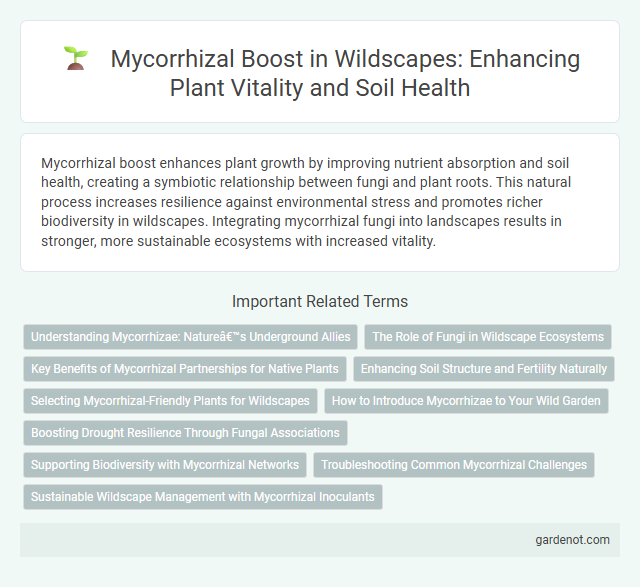Mycorrhizal boost enhances plant growth by improving nutrient absorption and soil health, creating a symbiotic relationship between fungi and plant roots. This natural process increases resilience against environmental stress and promotes richer biodiversity in wildscapes. Integrating mycorrhizal fungi into landscapes results in stronger, more sustainable ecosystems with increased vitality.
Understanding Mycorrhizae: Nature’s Underground Allies
Mycorrhizal fungi form symbiotic relationships with plant roots, enhancing nutrient and water uptake essential for robust plant growth in wildscapes. These underground allies extend the root system, improving soil structure and boosting plant resilience against environmental stressors. Utilizing mycorrhizal inoculants in wildscape restoration promotes biodiversity, healthy ecosystems, and sustainable plant development.
The Role of Fungi in Wildscape Ecosystems
Mycorrhizal fungi form symbiotic relationships with plant roots in Wildscape ecosystems, enhancing nutrient uptake and improving soil health. These fungi increase plant resilience by facilitating water absorption and protecting roots from pathogens. Their presence is crucial for maintaining biodiversity and ecosystem stability in wild landscapes.
Key Benefits of Mycorrhizal Partnerships for Native Plants
Mycorrhizal partnerships enhance nutrient uptake by connecting native plant roots to a vast fungal network that improves access to phosphorus and nitrogen essential for growth. These symbiotic relationships increase drought resistance and bolster plant health by improving soil structure and moisture retention. Enhanced root development and disease resistance from mycorrhizal associations lead to stronger native plant populations and more resilient ecosystems.
Enhancing Soil Structure and Fertility Naturally
Mycorrhizal boost significantly improves soil structure by increasing aggregation and porosity, leading to better water retention and aeration for plant roots. The symbiotic fungi enhance nutrient availability, particularly phosphorus, by extending the root system's reach and facilitating nutrient exchange. This natural enhancement promotes healthier plant growth and sustainable soil fertility without chemical inputs.
Selecting Mycorrhizal-Friendly Plants for Wildscapes
Selecting mycorrhizal-friendly plants for wildscapes enhances soil health and boosts native biodiversity by promoting symbiotic fungal relationships that improve nutrient uptake. Species such as oaks, pines, and native wildflowers naturally support mycorrhizal networks, facilitating better growth and drought resistance. Integrating these plants ensures a resilient wildscape ecosystem with increased carbon sequestration and habitat complexity.
How to Introduce Mycorrhizae to Your Wild Garden
Introducing mycorrhizae to your wild garden enhances soil health and promotes robust plant growth by forming beneficial fungal-root partnerships. Apply mycorrhizal inoculants directly to the root zone of seedlings or mature plants during planting or transplanting for optimal colonization. Incorporating organic matter such as compost helps create a conducive environment for mycorrhizal fungi to thrive and support native vegetation.
Boosting Drought Resilience Through Fungal Associations
Mycorrhizal boost enhances plant drought resilience by improving water absorption through extensive fungal networks that connect to root systems. These symbiotic fungi increase soil moisture retention and nutrient uptake, strengthening plants against prolonged dry conditions. Wildscape ecosystems benefit significantly from mycorrhizal associations, promoting sustainable growth in drought-prone environments.
Supporting Biodiversity with Mycorrhizal Networks
Mycorrhizal boost enhances soil health by promoting symbiotic relationships between fungi and plant roots, facilitating nutrient exchange and improving plant growth. This network supports biodiversity by connecting diverse plant species, enabling resilient ecosystems and increased habitat complexity. Strengthening mycorrhizal networks in wildscapes fosters sustainable ecosystems critical for wildlife habitat and ecosystem services.
Troubleshooting Common Mycorrhizal Challenges
Mycorrhizal Boost often faces challenges such as poor colonization due to inappropriate soil pH or excessive chemical fertilizers that inhibit fungal growth. Identifying low spore viability and correcting environmental factors like moisture levels can enhance symbiotic effectiveness. For optimal results, ensure the application aligns with Wildscape's recommended conditions, including soil temperature and organic content.
Sustainable Wildscape Management with Mycorrhizal Inoculants
Mycorrhizal inoculants enhance soil health by establishing symbiotic relationships with plant roots, improving nutrient uptake and water retention. Sustainable Wildscape Management leverages these natural fungi to increase plant resilience and biodiversity, reducing the need for chemical fertilizers and irrigation. Integrating mycorrhizal boost techniques supports ecosystem stability, promoting long-term environmental balance and sustainable habitat restoration.
Mycorrhizal boost Infographic

 gardenot.com
gardenot.com